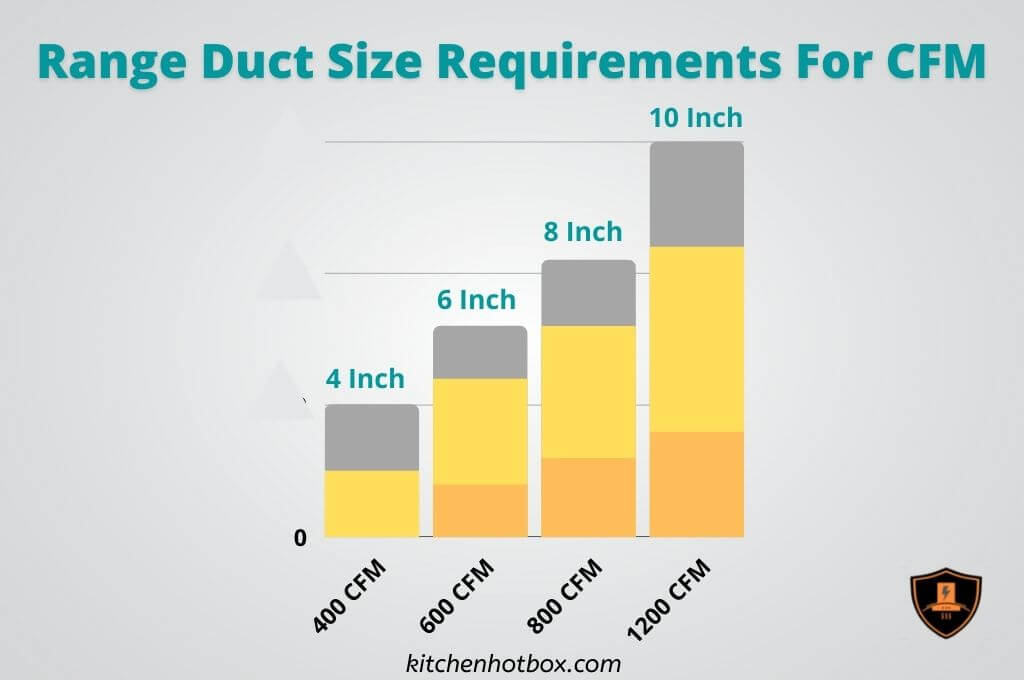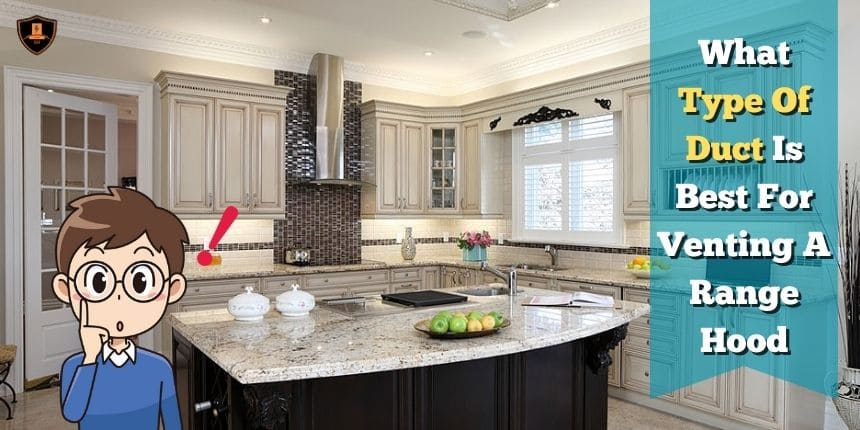Range hood maintains a healthy environment in the kitchen by carrying away toxic smoke and substances from the kitchen. To operate this procedure, adequate ducts are required to circulate the toxic elements properly. If the range hood venting options is not good, the machine loses its performance for a long time.
So today, we will discuss here what type of duct is best for venting a range hood. The discussion will be about the type of range hood ductwork, what kind of duct for range hood is used, and how to install duct for range hood. Let’s start,
What Type of Duct Is Best for Venting a Range Hood – Types of Ducts for Range Hood
The best duct for venting a range hood is a rigid duct. Because the digit duct is made of numerous materials and is often used because of its hard durability, this article will explore more about what it is and its alternatives. Also, there is various rules and codes use of involving ducts.

Rigid Duct for Range Hood
A rigid duct is typically made of metal, such as galvanized steel or stainless steel, and comes in straight sections that are joined together with duct connectors. The most ideal range hood ducting is stainless steel rigid metal ducting. This allows for efficient and effective ventilation and helps prevent the buildup of heat, moisture, and cooking odors in the kitchen and the duct. The use of rigid ducts for the range hood ensures maximum safety as per International Residential Code. For kitchen ventilation, rigid ducting for range hoods is a reliable and durable solution.
Semi-Rigid Duct for Range Hood – Can You Use Semi Rigid Duct for Range Hood

The semi-rigid duct is used for the ductwork of range hood, but according to IRC, its material is not recommended for range hoods duct.
The semi-rigid duct is a combination of aluminium. Depending on its durability and functionality, it can be positioned between rigid and flexible ducts. But it is the better version of rangehood flexible duct. Yet, it is not acceptable for its material as it is made of aluminium which is against the IRC regulations. Although semi-rigid duct performs better than flexible, still aluminum is not good material for use as ventilation of range hood. Check out here if you require Semi Rigid Duct today, 6 inch semi rigid duct for range hood
Flexible Duct for Range Hood – Can You Use Flexible Duct for Range Hood
Many are seen using flexible duct for range hood ductwork. People may use it without understanding it or without understanding how it works. But according to the International Residential Code – IRC (2015) Section M1503, “using a flex duct for a range hood is not permitted for a variety of safety reasons.”
A flexible duct cannot be used for a range hood based on IRC rules and code premises. Homeowners should not use range hood flexible ducts for venting a kitchen hood ductwork considering health and safety. Due to the corrugated nature of flexible ducts, grease, and grime released from range hoods can accumulate here and build up on corrugated steps. Due to grease’s flammability, that can lead to a fire. In addition, grease and grime build-up slows down the rate of airflow, which affects the whole performance of the range hood.
In contrast, flexible ducts are made out of plastic or aluminum, which is out of the IRC (International Residential Code) durability of the acceptable materials list. So, we can see that the flexible duct is not accepted by the IRC criteria and is not permitted. Visit here if you require a range hood Flexible Duct right now.
PVC Duct Pipe for Range Hood – Can You Use PVC Pipe for a Range Hood
PVC duct pipe is ignored for the same reasons that range hood flexible duct is. Since PVC duct pipe is made of plastic, it is discouraged as per IRC regulation. In certain conditions, only downdraft exhaust systems are useful. Ducts for domestic kitchen cooking appliances equipped with downdraft exhaust systems shall be permitted to be constructed of schedule 40 PVC pipe.
- These five regulations that must be adhered to, if PVC is to be used, are as follows:
- The PVC must be installed beneath a slab of concrete on the ground level.
- The trench dug for the PVC must be filled with gravel or sand.
- The duct cannot protrude more than 1″ (25 mm) above the concrete inside the house.
- The duct cannot protrude more than 1″ (25 mm) above the concrete outside of the house.
- The ducts must be solvent cemented.
Despite being made of metal, the rigid ducts couldn’t support the weight of the concrete slab on the bottom of the house. PVC duct pipe is needed when metal ducts are placed under the ground in contact with concrete cement in cases where the metal ducts can be affected by rust. However, PVC pipe cannot be used in the traditional venting management of range hood. If it is a downdraft exhaust system then it is appropriate.
What is a Duct System?
A house has many appliances such as fans, blowers, range hoods, etc. And the medium or object used for the ventilation system from those machines is duct or ductwork. A duct is a channel through which the various ventilation activities of a house are emitted, emitting contaminated indoor air outside.
What is The Minimum Duct Size for a Range Hood – How Big Should the Duct Be for Range Hood
The minimum duct size for a range hood is 6-inch diameter. If you want to ensure that pollutants are removed from the indoor air and maintain good indoor air quality, you need to choose the right duct size for the appropriate range hood.

What is the minimum duct size for a range hood duct depends on the machine’s specification, size, and power of itself. A minimum diameter of 6 inches is recommended by most range hood manufacturers for ducted range hoods. In the case of powerful range hoods with high CFM (cubic feet per minute) ratings, a larger range hood vent duct size may be necessary to ensure proper ventilation. When ducts are too small, they can cause poor airflow and inefficient ventilation, while ducts that are too large may cause excessive noise and inadequate pollution removal.
When selecting what size duct for range hood, be sure to maintain local building codes or regulations that may apply and consult with the manufacturer’s specifications and recommendations as well.
Super Tips: Aside from the size of the duct for the range hood, there is also another thing to keep in mind the range hood duct length. If you want better airflow you have to maintain a shorter duct. On the other hand, if you want to maintain a smooth exhaust system you have to keep in mind the use of elbows using. Otherwise, your ductwork faces many obstacles to passing the air through it. The cooking air should be ducted upward since the upward duct is the most logical choice to get it out of the kitchen as soon as possible.
How Do I Know What Size Flex Duct I Need?
Flexed duct needs to be measured the size accurately based on the size of the machine and CFM (cubic feet per minute) to conduct its activities appropriately.
Step 1- Determine the square foot of the room:
Measure the room size in square feet by multiplying the length and width. For example, a 12-by-12 room will be 144 SF.
Step 2- Determine the CFM:
Calculate the amount of CFM by use of 1 CFM per sf of space. In our example, the 144 square feet room will need 144 CFM of air volume for appropriate ventilation.
Step 3- Figure out the flex size:
Use an online ductwork calculator to calculate the dimensions of the flex ducts. Select the duct type on the pull-down menu. Fill in the box below that with the required CFM. Click “Calculate” and you will see the size of the flex duct you need for that room.
Can I Use 4 Inch Duct for Range Hood
As mentioned earlier the minimum duct size for a range hood is 6″. Thus, a 4-inch duct should not be used for a range hood, especially if the range hood is large or has a high CFM (Cubic feet per minute) rating.
Smaller duct sizes can result in reduced airflow, ineffective ventilation, and potentially unsafe environments. 4 inch duct for the range vent duct is not enough to provide sufficient airflow to effectively remove contaminants. But a range hood 4 inch duct size is appropriate for low-CFM hoods under 400 CFM.
How to Install Duct for Range Hood – Range Hood Duct Installation
Range hood duct installation is a crucial part of setting up an effective kitchen ventilation system. A range hood with an external ducting system effectively removes cooking smoke, steam, and other airborne particles from your kitchen, helping to keep the air in your home fresh and healthy. Listed here is a step-by-step guide for installing range hood ducts. The specific installation process may vary depending on the type of range hood and ductwork you are installing, as well as local building codes and regulations.
- Identify the best location to install a range hood duct.
- Install a vent hood or wall cap on the exterior of your home to prevent pests and debris from entering the ductwork.
- Measure and cut the ductwork to the appropriate length, making sure to account for any bends or turns.
- Connect the ductwork using appropriate fittings and sealing materials to the range hood, vent hood, or wall cap.
- Put appropriate brackets and hangers on top of the ductwork to secure it in place.
- Test the range hood and ductwork to ensure it is functioning properly and safely.
It’s always a good idea to consult the manufacturer’s installation instructions and seek professional assistance if you are unsure about any aspect of the installation process. We have a complete guide for how to install range hood ducting by range hood duct installation, you can check it out.
Range Hood Vent Duct Kit – Vent Kit For Range Hood
The range hood vent duct kit is one of the tools and accessories used to install the ductwork of a range hood. These components are mandatorily required for the installation of ductwork. Various types of vent kits for range hoods are available such as duct adaptors, reducers, expansion joints, wall caps or roof caps, clams, etc. If you need anything about range hood duct kit you can Check From Amazon.
Duct Tape for Range Hood
Duct tape is made from cloth and pressure-sensitive tape is a long-lasting adhesive tape that is often coated with polyethylene. Various purposes can be served by duct tape, including sealing, repairing, bundling, and holding objects together. Duct tape also known as cloth tape is a tape with high strength and water resistance. There are various types of duct tape for range hood ducts available on the market, which are distinguishable by their widths, lengths, colors, and grades. Best tape for range hood duct can be rated differently, depending on its use. Generally, duct tape grades depend on the adhesive used and the cloth backing strength.
Range Hood Duct Adapter
The purpose of a duct adaptor is to connect two different range hood vent sizes of duct pipe or ductwork together. Additionally, it is known as a duct connector or range hood transition adapter in HVAC systems for transitioning between range hood rectangular to round duct, or oval ducts or connecting a duct with a vent. According to each ductwork’s needs and benefits, this adapter comes in different sizes and shapes.
Duct adaptors may be used in various segments. A duct adaptor ensures a secure, airtight link between two ductworks. Also, it may help decrease the noise and vibration level in the ductwork.
Range Hood Vent Duct Reducer
A range hood duct reducer is mainly used for connecting a duct of one diameter with a duct of a relatively small or large diameter. Generally, the use of a duct reducer is more noticeable for connecting ducts of smaller diameter than a duct. Range hood vent pipe duct reducer enables a change of the current duct to another diameter duct to help the function of ductwork installation.
A vent duct reducer is a vital element in range hood venting. A duct reducer, on the one hand, is helpful in the convenient installation of ductwork, and on the other hand, it has an effective effect on ductwork noise level reduction. The duct reducer has the responsibility to ensure efficient airflow from the hood to the ductwork.
Final Words
Our team tries to introduce necessary information about what type of duct is best for venting a range hood. We have tried to present an article with the utmost information about what type of duct for range hood in front of the eyes of our readers. Throughout this article, you are able to learn what duct to use for range hoods as well as gain knowledge about different types of range hood ducts.
Finally, it has to be said that according to your range hood’s needs and requirements, you should consider the duct type as recommended by the manufacturer. You can find more information about hoods at the following links!
Related Article:
How Do I Know If My Range Hood Is Ducted Or Ductless


1 thought on “What Type Of Duct Is Best For Venting A Range Hood – 4 Options You Must Learn”